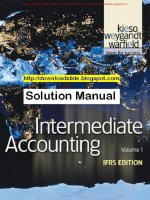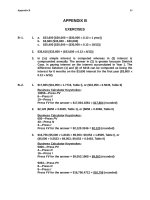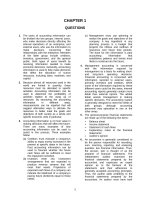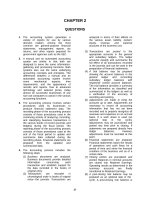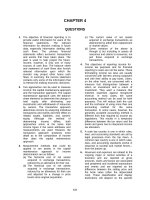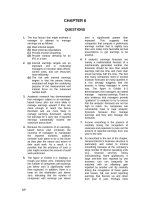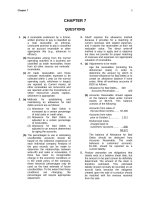Solution manual intermediate accounting 7th by nelson spiceland ch01
Bạn đang xem bản rút gọn của tài liệu. Xem và tải ngay bản đầy đủ của tài liệu tại đây (324.54 KB, 35 trang )
Find more slides, ebooks, solution manual and testbank on www.downloadslide.com
Chapter 1
Environment and Theoretical Structure of
Financial Accounting
AACSB assurance of learning standards in accounting and business education require
documentation of outcomes assessment. Although schools, departments, and faculty may approach
assessment and its documentation differently, one approach is to provide specific questions on
exams that become the basis for assessment. To aid faculty in this endeavor, we have labeled each
question, exercise and problem in Intermediate Accounting, 7e with the following AACSB learning
skills:
Questions
AACSB Tags
1–1
1–2
1–3
1–4
1–5
1–6
1–7
1–8
1–9
1–10
1–11
1–12
1–13
1–14
1–15
1–16
1–17
1–18
1–19
1–20
1–21
1–22
1–23
1–24
1–25
1–26
1–27
1–28
1–29
Reflective thinking
Reflective thinking
Reflective thinking
Reflective thinking
Reflective thinking
Reflective thinking
Reflective thinking
Reflective thinking
Reflective thinking
Reflective thinking
Reflective thinking
Reflective thinking
Reflective thinking
Reflective thinking
Reflective thinking
Reflective thinking
Reflective thinking
Reflective thinking
Reflective thinking
Reflective thinking
Reflective thinking
Reflective thinking
Reflective thinking
Reflective thinking
Reflective thinking
Reflective thinking
Reflective thinking
Reflective thinking
Reflective thinking
Solutions Manual, Vol.1, Chapter 1
1–30
1–31
1–32
Reflective thinking
Reflective thinking
Reflective thinking
Brief Exercises
AACSB Tags
1–1
1–2
1–3
1–4
1–5
1–6
Analytic
Reflective thinking
Reflective thinking
Reflective thinking
Reflective thinking
Reflective thinking
Exercises
AACSB Tags
1–1
1–2
1–3
1–4
1–5
1–6
1–7
1–8
1–9
1–10
1–11
1–12
1–13
1–14
1–15
Analytic
Analytic
Communications
Communications
Reflective thinking
Reflective thinking
Reflective thinking
Reflective thinking
Reflective thinking
Reflective thinking
Reflective thinking
Reflective thinking
Reflective thinking
Reflective thinking
Reflective thinking
© The McGraw-Hill Companies, Inc., 2013
1-1
Find more slides, ebooks, solution manual and testbank on www.downloadslide.com
CPA/CMA
AACSB Tags
1
2
3
4
5
6
7
8
9
10
11
1
2
Reflective thinking
Reflective thinking
Reflective thinking
Reflective thinking
Reflective thinking
Reflective thinking
Diversity, Reflective thinking
Reflective thinking
Diversity, Reflective thinking
Diversity, Reflective thinking
Diversity, Reflective thinking
Reflective thinking
Reflective thinking
3
Reflective thinking
© The McGraw-Hill Companies, Inc., 2013
1-2
Intermediate Accounting 7/e
Find more slides, ebooks, solution manual and testbank on www.downloadslide.com
QUESTIONS FOR REVIEW OF KEY TOPICS
Question 1–1
Financial accounting is concerned with providing relevant financial information about various
kinds of organizations to different types of external users. The primary focus of financial accounting
is on the financial information provided by profit-oriented companies to their present and potential
investors and creditors.
Question 1–2
Resources are efficiently allocated if they are given to enterprises that will use them to provide
goods and services desired by society and not to enterprises that will waste them. The capital
markets are the mechanism that fosters this efficient allocation of resources.
Question 1–3
Two extremely important variables that must be considered in any investment decision are the
expected rate of return and the uncertainty or risk of that expected return.
Question 1–4
In the long run, a company will be able to provide investors and creditors with a rate of return
only if it can generate a profit. That is, it must be able to use the resources provided to it to generate
cash receipts from selling a product or service that exceed the cash disbursements necessary to
provide that product or service.
Question 1–5
The primary objective of financial accounting is to provide investors and creditors with
information that will help them make investment and credit decisions.
Question 1–6
Net operating cash flows are the difference between cash receipts and cash disbursements
during a period of time from transactions related to providing goods and services to customers. Net
operating cash flows may not be a good indicator of future cash flows because, by ignoring
uncompleted transactions, they may not match the accomplishments and sacrifices of the period.
Solutions Manual, Vol.1, Chapter 1
© The McGraw-Hill Companies, Inc., 2013
1-3
Find more slides, ebooks, solution manual and testbank on www.downloadslide.com
Answers to Questions (continued)
Question 1–7
GAAP (generally accepted accounting principles) are a dynamic set of both broad and specific
guidelines that a company should follow in measuring and reporting the information in their
financial statements and related notes. It is important that all companies follow GAAP so that
investors can compare financial information across companies to make their resource allocation
decisions.
Question 1–8
In 1934, Congress created the SEC and gave it the job of setting accounting and reporting
standards for companies whose securities are publicly traded. The SEC has retained the power, but
has delegated the task to private sector bodies. The current private sector body responsible for
setting accounting standards is the FASB.
Question 1–9
Auditors are independent, professional accountants who examine financial statements to
express an opinion. The opinion reflects the auditors’ assessment of the statements' fairness, which
is determined by the extent to which they are prepared in compliance with GAAP. The auditor adds
credibility to the financial statements, which increases the confidence of capital market participants
relying on that information.
Question 1–10
On July 30, 2002, President Bush signed into law the Sarbanes-Oxley Act of 2002. The most
dramatic change to federal securities laws since the 1930s, the Act radically redesigns federal
regulation of public company corporate governance and reporting obligations. It also significantly
tightens accountability standards for directors and officers, auditors, securities analysts, and legal
counsel. Student opinions as to the relative importance of the key provisions of the act will vary.
Key provisions in the order of presentation in the text are:
Creation of an Oversight Board
Corporate executive accountability
Nonaudit services
Retention of work papers
Auditor rotation
Conflicts of interest
Hiring of auditor
Internal control
© The McGraw-Hill Companies, Inc., 2013
1-4
Intermediate Accounting 7/e
Find more slides, ebooks, solution manual and testbank on www.downloadslide.com
Answers to Questions (continued)
Question 1–11
New accounting standards, or changes in standards, can have significant differential effects on
companies, investors and creditors, and other interest groups by causing redistribution of wealth.
There also is the possibility that standards could harm the economy as a whole by causing
companies to change their behavior.
Question 1–12
The FASB undertakes a series of elaborate information gathering steps before issuing an
accounting standard to determine consensus as to the preferred method of accounting, as well as to
anticipate adverse economic consequences.
Question 1–13
The purpose of the conceptual framework is to guide the Board in developing accounting
standards by providing an underlying foundation and basic reasoning on which to consider merits of
alternatives. The framework does not prescribe GAAP.
Question 1–14
Relevance and faithful representation are the primary qualitative characteristics that make
information decision-useful. Relevant information will possess predictive and/or confirmatory
value. Faithful representation is the extent to which there is agreement between a measure or
description and the phenomenon it purports to represent.
Question 1–15
The components of relevant information are predictive and/or confirmatory value.
components of faithful representation are completeness, neutrality, and freedom from error.
The
Question 1–16
The benefit from providing accounting information is increased decision usefulness. If the
information is relevant and possesses faithful representation, it will improve the decisions made by
investors and creditors. However, there are costs to providing information that include costs to
gather, process, and disseminate that information. There also are costs to users in interpreting the
information as well as possible adverse economic consequences that could result from disclosing
information. Information should not be provided unless the benefits exceed the costs.
Solutions Manual, Vol.1, Chapter 1
© The McGraw-Hill Companies, Inc., 2013
1-5
Find more slides, ebooks, solution manual and testbank on www.downloadslide.com
Answers to Questions (continued)
Question 1–17
Information is material if it is deemed to have an effect on a decision made by a user. The
threshold for materiality will depend principally on the relative dollar amount of the transaction
being considered. One consequence of materiality is that GAAP need not be followed in measuring
and reporting a transaction if that transaction is not material. The threshold for materiality has been
left to subjective judgment.
Question 1–18
1.
Assets are probable future economic benefits obtained or controlled by a particular entity as a
result of past transactions or events.
2.
Liabilities are probable future sacrifices of economic benefits arising from present obligations
of a particular entity to transfer assets or provide services to other entities in the future as a
result of past transactions.
3.
Equity is the residual interest in the assets of any entity that remains after deducting its
liabilities.
4.
Investments by owners are increases in equity resulting from transfers of resources, usually
cash, to a company in exchange for ownership interest.
5.
Distributions to owners are decreases in equity resulting from transfers to owners.
6.
Revenues are inflows of assets or settlements of liabilities from delivering or producing goods,
rendering services, or other activities that constitute the entity’s ongoing major or central
operations.
7.
Expenses are outflows or other using up of assets or incurrences of liabilities during a period
from delivering or producing goods, rendering services, or other activities that constitute the
entity’s ongoing major or central operations.
8.
Gains are defined as increases in equity from peripheral or incidental transactions of an entity.
9.
Losses represent decreases in equity arising from peripheral or incidental transactions of an
entity.
10. Comprehensive income is defined as the change in equity of an entity during a period from
nonowner transactions.
Question 1–19
The four basic assumptions underlying GAAP are (1) the economic entity assumption, (2) the
going concern assumption, (3) the periodicity assumption, and (4) the monetary unit assumption.
Question 1–20
The going concern assumption means that, in the absence of information to the contrary, it is
anticipated that a business entity will continue to operate indefinitely. This assumption is important
to many broad and specific accounting principles such as the historical cost principle.
© The McGraw-Hill Companies, Inc., 2013
1-6
Intermediate Accounting 7/e
Find more slides, ebooks, solution manual and testbank on www.downloadslide.com
Answers to Questions (continued)
Question 1–21
The periodicity assumption relates to needs of external users to receive timely financial
information. This assumption requires that the economic life of a company be divided into artificial
periods for financial reporting. Companies usually report to external users at least once a year.
Question 1–22
The four key broad accounting principles that guide accounting practice are (1) the historical
cost or original transaction value principle, (2) the realization or revenue recognition principle, (3)
the matching principle, and (4) the full disclosure principle.
Question 1–23
Two important reasons to base valuation on historical cost are (1) historical cost provides
important cash flow information since it represents the cash or cash equivalent paid for an asset or
received in exchange for the assumption of a liability, and (2) historical cost valuation is the result of
an exchange transaction between two independent parties and the agreed upon exchange value is,
therefore, objective and possesses a high degree of verifiability.
Question 1–24
The realization principle requires that two criteria be satisfied before revenue can be
recognized:
1. The earnings process is judged to be complete or virtually complete, and,
2. There is reasonable certainty as to the collectibility of the asset to be received (usually
cash).
Solutions Manual, Vol.1, Chapter 1
© The McGraw-Hill Companies, Inc., 2013
1-7
Find more slides, ebooks, solution manual and testbank on www.downloadslide.com
Answers to Questions (continued)
Question 1–25
The four different approaches to implementing the matching principle are:
1. Recognizing an expense based on an exact cause-and-effect relationship between a revenue
and expense event. Cost of goods sold is an example of an expense recognized by this
approach.
2. Recognizing an expense by identifying the expense with the revenues recognized in a
specific time period. Office salaries are an example of an expense recognized by this
approach.
3. Recognizing an expense by a systematic and rational allocation to specific time periods.
Depreciation is an example of an expense recognized by this approach.
4. Recognizing expenses in the period incurred, without regard to related revenues.
Advertising is an example of an expense recognized by this approach.
Question 1–26
In addition to the financial statement elements arrayed in the basic financial statements,
information is disclosed by means of parenthetical or modifying comments, notes, and supplemental
financial statements.
Question 1–27
GAAP prioritizes the inputs companies should use when determining fair value. The highest
and most desirable inputs, Level 1, are quoted market prices in active markets for identical assets or
liabilities. Level 2 inputs are other than quoted prices that are observable, including quoted prices
for similar assets or liabilities in active or inactive markets and inputs that are derived principally
from observable related market data. Level 3 inputs, the least desirable, are inputs that reflect the
entity’s own assumptions about the assumptions market participants would use in pricing the asset or
liability based on the best information available in the circumstances.
Question 1–28
Common measurement attributes are historical cost, net realizable value, present value, and
fair value.
Question 1–29
Under the revenue/expense approach, revenues and expenses are considered primary, and
assets, liabilities, and equities are secondary in the sense of being recognized at the time and amount
necessary to achieve proper revenue and expense recognition. Under the asset/liability approach,
assets and liabilities are considered primary, and revenues and expenses are secondary in the sense
of being recognized at the time and amount necessary to allow recognition and measurement of
assets and liabilities as required by their definitions.
© The McGraw-Hill Companies, Inc., 2013
1-8
Intermediate Accounting 7/e
Find more slides, ebooks, solution manual and testbank on www.downloadslide.com
Answers to Questions (concluded)
Question 1–30
Under IFRS, the conceptual framework provides guidance to accounting standard setters but
also provides GAAP when more specific accounting standards do not provide guidance.
Question 1–31
The International Accounting Standards Board (IASB) is responsible for determining IFRS.
The IASB is funded by the International Accounting Standards Committee Foundation (IASCF),
which in turn receives much of its funding through voluntary donations by accounting firms and
corporations.
Question 1–32
The SEC issued two studies comparing U.S. GAAP and IFRS and analyzing how IFRS are
applied globally. In these studies, the SEC identified key differences between U.S. GAAP and
IFRS, and noted that U.S. GAAP provides significantly more guidance about particular transactions
or industries. The SEC also noted some diversity in the application of IFRS that suggests the
potential for non-comparability of financial statements across countries and industries. The SEC
postponed making a final decision about conversion to IFRS, but continued to discuss
“condorsement” as a reasonable approach.
Solutions Manual, Vol.1, Chapter 1
© The McGraw-Hill Companies, Inc., 2013
1-9
Find more slides, ebooks, solution manual and testbank on www.downloadslide.com
BRIEF EXERCISES
Brief Exercise 1–1
Revenues ($340,000 + 60,000)
Expenses:
Rent ($40,000 y 2)
Salaries
Utilities ($50,000 + 2,000)
Net income
$400,000
(20,000)
(120,000)
(52,000)
$208,000
Brief Exercise 1–2
(1) Liabilities
(2) Assets
(3) Revenues
(4) Losses
Brief Exercise 1–3
1.
2.
3.
4.
The periodicity assumption
The economic entity assumption
The realization (revenue recognition) principle
The matching principle
Brief Exercise 1–4
1. The matching principle
2. The historical cost (original transaction value) principle
3. The economic entity assumption
Brief Exercise 1–5
1.
2.
3.
4.
Disagree
Agree
Disagree
Agree
—
—
—
—
The full disclosure principle
The periodicity assumption
The matching principle
The realization (revenue recognition) principle
© The McGraw-Hill Companies, Inc., 2013
1-10
Intermediate Accounting 7/e
Find more slides, ebooks, solution manual and testbank on www.downloadslide.com
Brief Exercise 1–6
1. Obtains funding for the IFRS standard setting process: International Accounting
Standards Committee Foundation (IASCF)
2. Determines IFRS: International Accounting Standards Board (IASB)
3. Encourages cooperation among securities regulators to promote effective and
efficient capital markets: International Organization of Securities Commissions
(IOSCO)
4. Provides input about the standard setting agenda: Standards Advisory Council
(SAC).
5. Provides implementation guidance about relatively narrow emerging issues
International Financial Reporting Interpretations Committee (IFRIC).
Solutions Manual, Vol.1, Chapter 1
© The McGraw-Hill Companies, Inc., 2013
1-11
Find more slides, ebooks, solution manual and testbank on www.downloadslide.com
EXERCISES
Exercise 1–1
Requirement 1
Pete, Pete, and Roy
Operating Cash Flow
Cash collected
Cash disbursements:
Salaries
Utilities
Purchase of insurance policy
Net operating cash flow
Year 1
$160,000
Year 2
$190,000
(90,000)
(30,000)
(60,000)
$(20,000)
(100,000)
(40,000)
-0$ 50,000
Requirement 2
Pete, Pete, and Roy
Income Statements
Revenues
Expenses:
Salaries
Utilities
Insurance
Net Income
Year 1
$170,000
Year 2
$220,000
(90,000)
(35,000)
(20,000)
$ 25,000
(100,000)
(35,000)
(20,000)
$ 65,000
Requirement 3
Year 1: Amount billed to customers
Less: Cash collected
Ending accounts receivable
$170,000
(160,000)
$ 10,000
Year 2: Beginning accounts receivable
Plus: Amounts billed to customers
$ 10,000
220,000
$230,000
(190,000)
$ 40,000
Less: Cash collected
Ending accounts receivable
© The McGraw-Hill Companies, Inc., 2013
1-12
Intermediate Accounting 7/e
Find more slides, ebooks, solution manual and testbank on www.downloadslide.com
Exercise 1–2
Requirement 1
Revenues
Expenses:
Rent ($80,000 y 2)
Salaries
Travel and entertainment
Advertising
Net Income
Year 2
$350,000
Year 3
$450,000
(40,000)
(140,000)
(30,000)
(25,000)
$115,000
(40,000)
(160,000)
(40,000)
(20,000)*
$190,000
Requirement 2
Amount owed at the end of year one
Advertising costs incurred in year two
Amount paid in year two
Liability at the end of year two
Less cash paid in year three
Advertising expense in year three
Solutions Manual, Vol.1, Chapter 1
$ 5,000
25,000
30,000
(15,000)
15,000
(35,000)
$20,000*
© The McGraw-Hill Companies, Inc., 2013
1-13
Find more slides, ebooks, solution manual and testbank on www.downloadslide.com
Exercise 1–3
Requirement 1
FASB ASC 820: “Fair Value Measurements and Disclosures”
Requirement 2
The specific citation that describes the information that companies must disclose
about the use of fair value to measure assets and liabilities for recurring measurements
is FASB ASC 820–10–50–2: “Fair Value Measurements and Disclosures-OverallDisclosures.”
Requirement 3
The disclosure requirements are:
a.
b.
c.
d.
e.
The fair value measurements at the reporting date
The level within the fair value hierarchy in which the fair value measurements
in their entirety fall, segregating fair value measurements using any of the
following:
1. Quoted market prices in active markets for identical assets or liabilities
(Level 1).
2. Significant other observable inputs (Level 2).
3. Significant unobservable inputs (Level 3).
For fair value measurements using significant unobservable inputs (Level 3), a
reconciliation of the beginning and ending balances, separately presenting
changes during the period attributable to any of the following:
1. Total gains and losses for the period (realized and unrealized), segregating
those gains or losses included in earnings (or changes in net assets) are
reported in the statement of income (or activities).
2. Purchases, sales, issuances, and settlements (net).
3. Transfers in and/or out of Level 3 (for example, transfers due to changes in
the observability of significant inputs).
The amount of the total gains or losses for the period in (c)(1) included in
earnings (or changes in net assets) that are attributable to the change in
unrealized gains and losses relating to those assets and liabilities still held at the
reporting date and a description of where those unrealized gains and losses are
reported in the statement of income (or activities).
In annual periods only, the valuation technique(s) used to measure fair value
and a discussion of changes in valuation techniques, if any, during the period.
© The McGraw-Hill Companies, Inc., 2013
1-14
Intermediate Accounting 7/e
Find more slides, ebooks, solution manual and testbank on www.downloadslide.com
Exercise 1–4
The FASB Accounting Standards Codification represents the single source of
authoritative U.S. generally accepted accounting principles. The specific
citation for each of the following items is:
1. The topic number for business combinations:
FASB ASC 805: “Business Combinations.”
2. The topic number for related-party disclosures:
FASB ASC 850: “Related Party Disclosures.”
3. The topic, subtopic, and section number for the initial measurement
of internal-use software:
FASB ASC 350–40–30: “Intangibles–Goodwill and Other–Internal–Use
Software–Initial Measurement.”
4. The topic, subtopic, and section number for the subsequent
measurement of asset retirement obligations:
FASB ASC 410–20–35: “Asset Retirement and Environmental
Obligations–Asset Retirement Obligations–Subsequent Measurement.”
5. The topic, subtopic, and section number for the recognition of stock
compensation:
FASB ASC 718–10–25: “Compensation–Stock Compensation–Overall–
Recognition.”
Exercise 1–5
Organization
1. Securities and Exchange Commission
2. Financial Executives International
3. American Institute of Certified Public Accountants
4. Institute of Management Accountants
5. Association of Investment Management and Research
Solutions Manual, Vol.1, Chapter 1
Group
Users
Preparers
Auditors
Preparers
Users
© The McGraw-Hill Companies, Inc., 2013
1-15
Find more slides, ebooks, solution manual and testbank on www.downloadslide.com
Exercise 1–6
1.
2.
3.
4.
5.
6.
7.
8.
9.
10.
11.
12.
Liability
Distribution to owners
Revenue
Assets, liabilities and equity
Comprehensive income
Gain
Loss
Equity
Asset
Net income
Investment by owner
Expense
© The McGraw-Hill Companies, Inc., 2013
1-16
Intermediate Accounting 7/e
Find more slides, ebooks, solution manual and testbank on www.downloadslide.com
Exercise 1–7
List A
o
1. Predictive value
h
2. Relevance
g
a
j
3. Timeliness
4. Distribution to owners
5. Confirmatory value
e
6. Understandability
n
7. Gain
f
8. Faithful representation
k
9. Comprehensive income
p 10. Materiality
c 11. Comparability
m 12. Neutrality
l
d
13. Recognition
14. Consistency
b
i
15. Cost effectiveness
16. Verifiability
Solutions Manual, Vol.1, Chapter 1
List B
a. Decreases in equity resulting from transfers to
owners.
b. Requires consideration of the costs and value of
information.
c. Important for making interfirm comparisons.
d. Applying the same accounting practices over time.
e. Users understand the information in the context of the
decision being made.
f. Agreement between a measure and the phenomenon
it purports to represent.
g. Information is available prior to the decision.
h. Pertinent to the decision at hand.
i. Implies consensus among different measurers.
j. Information confirms expectations.
k. The change in equity from nonowner transactions.
l. The process of admitting information into financial
statements.
m. The absence of bias.
n. Results if an asset is sold for more than its book
value.
o. Information is useful in predicting the future.
p. Concerns the relative size of an item and its effect on
decisions.
© The McGraw-Hill Companies, Inc., 2013
1-17
Find more slides, ebooks, solution manual and testbank on www.downloadslide.com
Exercise 1–8
1.
2.
3.
4.
5.
6.
7.
8.
Materiality
Neutrality
Consistency
Timeliness
Predictive value and/or confirmatory value
Faithful representation
Comparability
Cost effectiveness
Exercise 1–9
List A
d
1. Matching principle
g
e
i
2.
3.
4.
h
c
5.
6.
b
7.
a
f
8.
9.
List B
a. The enterprise is separate from its owners and other
entities.
Periodicity
b. A common denominator is the dollar.
Historical cost principle
c. The entity will continue indefinitely.
Materiality
d. Record expenses in the period the related revenue is
recognized.
Realization principle
e. The original transaction value upon acquisition.
Going concern assumption
f. All information that could affect decisions should be
reported.
Monetary unit assumption
g. The life of an enterprise can be divided into artificial
time periods.
Economic entity assumption h. Criteria usually satisfied at point of sale.
Full-disclosure principle
i. Concerns the relative size of an item and its effect on
decisions.
Exercise 1–10
1.
2.
3.
4.
5.
6.
7.
The economic entity assumption
The periodicity assumption
The matching principle (also the going concern assumption)
The historical cost (original transaction value) principle
The realization (revenue recognition) principle
The going concern assumption
Materiality
© The McGraw-Hill Companies, Inc., 2013
1-18
Intermediate Accounting 7/e
Find more slides, ebooks, solution manual and testbank on www.downloadslide.com
Exercise 1–11
1.
2.
3.
4.
5.
6.
The historical cost (original transaction value) principle
The periodicity assumption
The realization (revenue recognition) principle
The economic entity assumption
The matching principle; materiality
The full disclosure principle
Exercise 1–12
1.
2.
3.
4.
5.
6.
7.
Disagree
Disagree
Agree
Disagree
Agree
Agree
Disagree
—
—
—
—
—
—
—
Monetary unit assumption
Full disclosure principle
The matching principle
Historical cost (original transaction value) principle
Realization (revenue recognition) principle
Materiality
Periodicity assumption
1. Disagree
—
2. Disagree
3. Disagree
—
—
4. Agree
5. Agree
6. Disagree
—
—
—
This is a violation of the historical cost (original
transaction value) principle.
This is a violation of the economic entity assumption.
This is a violation of the realization (revenue recognition)
principle.
The company is conforming to the matching principle.
The company is conforming to the full disclosure principle.
This is a violation of the periodicity assumption.
Exercise 1–13
Solutions Manual, Vol.1, Chapter 1
© The McGraw-Hill Companies, Inc., 2013
1-19
Find more slides, ebooks, solution manual and testbank on www.downloadslide.com
Exercise 1–14
Statement
1.
2.
3.
4.
5.
6.
7.
8.
9.
10.
11.
Assumption, Principle, Constraint
f. Realization principle
h. Full-disclosure principle
g. Matching principle
e. Historical cost principle
c. Periodicity assumption
a. Economic entity assumption
i. Cost effectiveness
j. Materiality
k. Conservatism
b. Going concern assumption
d. Monetary unit assumption
Exercise 1–15
1.
2.
3.
4.
5.
6.
b
d
c
d
b
b
© The McGraw-Hill Companies, Inc., 2013
1-20
Intermediate Accounting 7/e
Find more slides, ebooks, solution manual and testbank on www.downloadslide.com
CPA / CMA REVIEW QUESTIONS
CPA Exam Questions
1. a. Auditor independence is not a qualitative characteristic.
2. b. Neutrality is an attribute of faithful representation.
3. b. The FASB is a private body, though the SEC has the ultimate authority to set
accounting standards. The FASB does not set auditing standards nor does it
consist entirely of the members of the American Institute of CPAs.
4. a. Confirmatory value is an ingredient of the primary quality of relevance.
5. d. Predictive value is an ingredient of relevance.
6. b. Completeness is an ingredient of faithful representation.
7. b. The objective of financial reporting is to provide information that is useful to
present and potential investors and creditors and other users in making
rational investment, credit, and other similar decisions.
8. d. Comprehensive income excludes only owner transactions.
9. d. The equivalent to FASAC for the IASB is the Standards Advisory Council.
10. c. The conceptual framework does not include specific implementation
guidance for particular complex standards.
11. d. The SEC delayed making a decision about IFRS conversion, but indicated
that the delay would only last a few months.
Solutions Manual, Vol.1, Chapter 1
© The McGraw-Hill Companies, Inc., 2013
1-21
Find more slides, ebooks, solution manual and testbank on www.downloadslide.com
CMA Exam Questions
1. b. Accounting standards in the United States for nongovernmental entities
are set primarily by the private sector. The principle standard setters are
the FASB and the AICPA’s AcSEC.
2. c. Verifiability implies a consensus among different measurers.
3. c. The four fundamental recognition criteria are (1) the item meets the
definition of an element of financial statements, (2) the item has an
attribute measurable with sufficient reliability, (3) the information is
relevant, and (4) the information is reliable. In addition, revenue should
be recognized when it is realized or realizable and earned.
© The McGraw-Hill Companies, Inc., 2013
1-22
Intermediate Accounting 7/e
Find more slides, ebooks, solution manual and testbank on www.downloadslide.com
CASES
Judgment Case 1–1
Requirement 1
In the 1934 Securities Act, Congress gave the SEC the job of setting accounting
and reporting standards for companies whose securities are publicly traded. However,
the SEC, a government-appointed body, always has delegated the task of setting
accounting standards to the private sector. It is important to understand that the SEC
delegated only the task, not the power, to set standards. The power still lies with the
SEC. If the SEC does not agree with a particular standard promulgated by the private
sector, it can, and has in the past, require a change in the standard.
Requirement 2
1. SEC employees may not have the expertise necessary to set accounting
standards.
2. By delegating to a private sector body, the cost of setting accounting standards
is not borne by taxpayers.
3. By delegating to a private sector body, standards may gain greater acceptance
than if dictated by a public (government) body.
4. The SEC now has a buffer group between itself and concerned constituents.
The SEC avoids criticism if a mistake is made by the FASB.
Research Case 1–2
Requirement 2
The 1933 Act has two basic objectives:
1. To require that investors be provided with material information concerning
securities offered for public sale; and
2. To prevent misrepresentation, deceit, and other fraud in the sale of securities.
Requirement 3
EDGAR:
EDGAR, the Electronic Data Gathering, Analysis, and Retrieval system,
performs automated collection, validation, indexing, acceptance, and forwarding of
submissions by companies and others who are required by law to file forms with the
U.S. Securities and Exchange Commission. Publicly traded domestic companies use
EDGAR to make the majority of their filings. Form 10-K, or 10-KSB, which includes
the annual report, is required to be filed on EDGAR. Filings by foreign companies are
not required to be filed on EDGAR, but some of these companies do so voluntarily.
Solutions Manual, Vol.1, Chapter 1
© The McGraw-Hill Companies, Inc., 2013
1-23
Find more slides, ebooks, solution manual and testbank on www.downloadslide.com
Research Case 1–3
Requirement 1
The mission of the Financial Accounting Standards Board is to establish and
improve standards of financial accounting and reporting for the guidance and
education of the public, including issuers, auditors, and users of financial information.
Requirement 2
Answers to these questions will vary depending on the date the research is
conducted.
Requirement 3
The FASB receives many requests for action on various financial accounting and
reporting topics from all segments of a diverse constituency, including the SEC. The
auditing profession is sensitive to emerging trends in practice, and consequently it is a
frequent source of requests. Overall, requests for action include both new topics and
suggested review or reconsideration of existing pronouncements.
The FASB is alert to trends in financial reporting through observation of
published reports, liaison with interested organizations, and from recommendations
from and discussions with the Emerging Task Force. In addition, the staff receives
many technical inquiries by letter and by telephone, which may provide evidence that
a particular topic, or aspect of an existing pronouncement, has become a problem. The
FASB also is alert to changes in the financial reporting environment
that may be brought about by new legislation or regulatory decisions.
The Board turns to many other organizations and groups for advice and
information on various matters, including its agenda. Among the groups with which
liaison is maintained are the Financial Accounting Standards Advisory Council, the
Accounting Standards Executive Committee and Auditing Standards Board of the
AICPA, and the appropriate committees of such organizations as the Association for
Investment Management and Research, Financial Executives Institute, Institute of
Management Accountants, and Robert Morris Associates.
.
© The McGraw-Hill Companies, Inc., 2013
1-24
Intermediate Accounting 7/e
Find more slides, ebooks, solution manual and testbank on www.downloadslide.com
Research Case 1–4
Requirement 1
The IASB is committed to developing, in the public interest, a single set of highquality, understandable, and enforceable global accounting standards that require
transparent and comparable information in general purpose financial statements. In
addition, the IASB cooperates with national accounting standard-setters to achieve
convergence in accounting standards around the world.
Requirement 2
The IASB has 15 Board members, each with one vote.In January 2009, the
trustees voted to expand the size to 16 members by 2012.
Requirement 3
The answers to this question will vary depending on the date the research is
conducted. In 2011, the chairman of the IASB was Hans Hoogervorst.
Requirement 4
London, United Kingdom
Research Case 1–5
Requirement 2
In 1978, China’s enterprise reform program was initiated. Prior to 1978, all
business enterprises were state owned and run. Now, China’s companies exhibit a
considerable range of ownership structures. For example, the Contract Responsibility
System was introduced to provide financial incentives to both workers and managers
of state-owned enterprises. In addition, many state-owned enterprises were converted
into companies with limited liabilities similar to corporations in the United States.
Requirement 3
The author feels that the accounting environment in China differs considerably
from what is typically presumed by IAS.
In particular, the lack of
independent/professional auditing in China implies that the proposed detailed IASbased standards may be counterproductive in China.
Solutions Manual, Vol.1, Chapter 1
© The McGraw-Hill Companies, Inc., 2013
1-25
